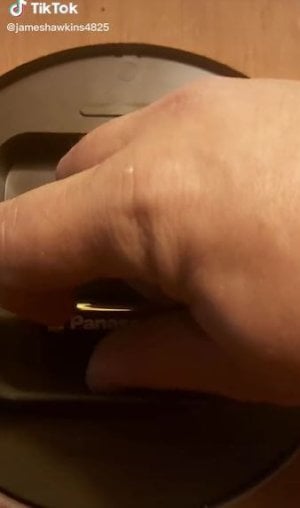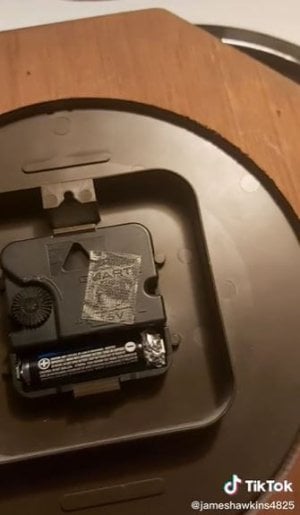You won't believe this ingenious hack that lets you turn AAA batteries into AA ones
- Replies 6
Ah, the familiar frustration of settling in to enjoy your favourite show, only to find that the batteries in your remote have breathed their last breath. You frantically search through your cupboards, looking for replacements, but alas, they're the wrong size. But fear not, my friend. A clever hack is all it takes to solve this pesky problem and restore your couch-potato paradise.
James Hawkins (who goes by @jameshawkins4825 on social media) recently demonstrated a battery hack involving a common household item.
He started the video by removing the AA battery from his wall-mounted clock.
Then he pops in the smaller AAA but shows that it doesn’t fit by moving the battery back and forth in the slot. So, he removes the smaller battery and pulls out a scrunched-up piece of alfoil, before placing it into the battery slot.
Afterwards, he takes the AAA battery and pushes one end against the scrunched-up alfoil until it ‘clicks’ into place. The video ends with James showing the wall-mounted clock working again.
‘AA Battery hack! Just a little foil turns any AAA into an AA,’ he captioned.
James’ fans were surprised at the simple hack.
‘OMG all these years and it was this easy,’ shared one.
‘Why did I not know this?’ Added another.
However, some were unimpressed – mainly because they believed the hack could be hazardous.
‘Wow, this is dangerous and should not be shown to anyone,’ wrote one.
‘Nice way to burn your house down’, echoed another.
We’ve done some research and we’re fairly sure this technique is reasonably safe if you use it as a very short-term fix only, and only with very ‘low risk’ items - i.e. things that are expendable and also not a fire hazard.
But why does it work? Well, the reason is that both AA and AAA batteries carry the same voltage - the only difference is their size. We’re going to get a little technical here so bear with us.
AAA batteries contain a smaller amount of electrochemical material than their larger cousins, meaning they generally hold less electric charge. In short, they store less power, which is why they are usually found in low-powered devices like remotes or clocks.
AA batteries, on the other hand, have around twice the capacity of AAA batteries, so they are made for devices that consume more power.
It’s worth noting that, depending on the device you’re using, the ‘alfoil hack’ might only buy you a couple of extra hours of usage since you’ll effectively be draining the power from your AAA batteries at twice their normal rate.
It’s also worth mentioning that there are some risks to consider if batteries are used inappropriately. While it may not be as dangerous compared to higher-voltage battery types, AAA or AA batteries still contain corrosive electrolytes that can cause harm if there’s a leakage.
In addition, many batteries contain hazardous chemicals that, when exposed to nature, can cause damage to ecosystems. So, before you throw out a battery, make sure to check with your local waste disposal centre to determine if it can be safely recycled.

Do you have other ‘hacks’ that you would like to share with the rest of us? Let us know in the comments!
James Hawkins (who goes by @jameshawkins4825 on social media) recently demonstrated a battery hack involving a common household item.
He started the video by removing the AA battery from his wall-mounted clock.
Then he pops in the smaller AAA but shows that it doesn’t fit by moving the battery back and forth in the slot. So, he removes the smaller battery and pulls out a scrunched-up piece of alfoil, before placing it into the battery slot.
Afterwards, he takes the AAA battery and pushes one end against the scrunched-up alfoil until it ‘clicks’ into place. The video ends with James showing the wall-mounted clock working again.
‘AA Battery hack! Just a little foil turns any AAA into an AA,’ he captioned.
James’ fans were surprised at the simple hack.
‘OMG all these years and it was this easy,’ shared one.
‘Why did I not know this?’ Added another.
However, some were unimpressed – mainly because they believed the hack could be hazardous.
‘Wow, this is dangerous and should not be shown to anyone,’ wrote one.
‘Nice way to burn your house down’, echoed another.
We’ve done some research and we’re fairly sure this technique is reasonably safe if you use it as a very short-term fix only, and only with very ‘low risk’ items - i.e. things that are expendable and also not a fire hazard.
But why does it work? Well, the reason is that both AA and AAA batteries carry the same voltage - the only difference is their size. We’re going to get a little technical here so bear with us.
AAA batteries contain a smaller amount of electrochemical material than their larger cousins, meaning they generally hold less electric charge. In short, they store less power, which is why they are usually found in low-powered devices like remotes or clocks.
AA batteries, on the other hand, have around twice the capacity of AAA batteries, so they are made for devices that consume more power.
It’s worth noting that, depending on the device you’re using, the ‘alfoil hack’ might only buy you a couple of extra hours of usage since you’ll effectively be draining the power from your AAA batteries at twice their normal rate.
It’s also worth mentioning that there are some risks to consider if batteries are used inappropriately. While it may not be as dangerous compared to higher-voltage battery types, AAA or AA batteries still contain corrosive electrolytes that can cause harm if there’s a leakage.
In addition, many batteries contain hazardous chemicals that, when exposed to nature, can cause damage to ecosystems. So, before you throw out a battery, make sure to check with your local waste disposal centre to determine if it can be safely recycled.
Key Takeaways
- One man shared his ‘hack’ to make AAA batteries fit into an AA battery slot.
- He said tinfoil can be used to turn on battery-operated devices when the batteries being used are too small.
- The hack is only a temporary fix and it is not recommended for prolonged use.









